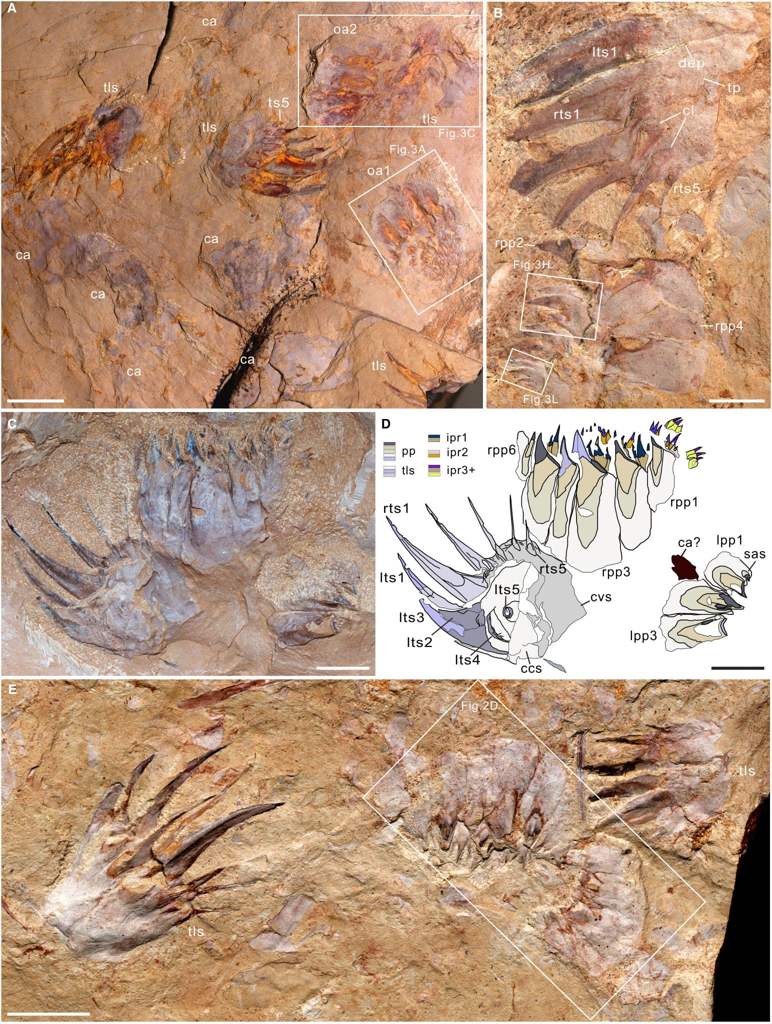Paleontologists have discovered a new Cambrian arthropod featuring claws near its mouth.
The fauna of the early Cambrian period (538.8-485.4 million years ago) is primarily known for its distinctive mollusks and arthropods. Among the latter were quite large marine predators, such as Omnidens amplus, the sole representative of its genus, whose length, according to some estimates, could reach up to two meters. However, only the fossilized mouthparts of this creature have been found, discovered in Cambrian shales in China.
In 2016, the jaws of O.amplus were compared with the arthropod Pambdelurion — the only known species of Pambdelurion whittingtoni — after which the two taxa were considered synonyms. Early Cambrian organisms are particularly interesting because they reveal the origins of the class Radiodonta, sometimes referred to as "monsters" and "beasts."
These large predators of ancient seas, as discovered in 2020, had complex eyes 500 million years ago. This finding confirmed the idea that vision was a crucial modification during the Cambrian explosion.
Recently, paleontologists from China and the UK reported the discovery of unusual appendages in the mouth of a prehistoric arthropod, indicating a new second species of the genus Omnidens. According to the researchers, the results compel a reevaluation of the origin of the circular mouthparts in Radiodonta and clarify the evolution of their ancestors' body plan. A detailed description of the find was published in the journal Papers in Palaeontology.
The specimens were collected from the Hunchun formation in Yunnan Province in southern China — which dates back to the third stage of the second division of the Cambrian period. This means that the creature whose remains were found lived approximately 521-514 million years ago. In total, scientists unearthed 18 articulated remains and 26 plates with scattered elements.

The mouthparts of the animal were apparently not circular but consisted of two paired rows of claw-like plates on the "jaws." This characteristic led the authors of the study to classify the arthropod as a new species — Omnidens qiongqii. The name is derived from one of the four fierce beasts in ancient Chinese mythology, Qiongqi, depicted as a tiger with wings and spines. The teeth of this fantastic creature, according to paleontologists, resemble the mouthparts of the extinct arthropod.
Experts counted 10 claw-like structures on each "jaw" (five on the left and five on the right) of the ancient predator — such impressive weaponry indicates a specific feeding mechanism. The length and width of the largest spine reached 3.8 and 1.4 centimeters, respectively. The smallest claw measured four millimeters in length and three in width. When the mouth was closed, these structures, arranged in a fan from the longest in the center to the shorter ones on the sides, would close and grasp the prey. Each also had a single spine directed downward.
This combination of features surprised scientists, as the traits do not fit the notion that Radiodonta acquired a circular mouth structure from molting (Ecdysozoa), a clade of protostomes. It is possible that Radiodonta invented this mouth configuration rather than inherited it.
The authors of the study also noted that the claws, located on the left and right of the two "jaws" of the Cambrian arthropod, are a hard part of the body. This detail, according to paleontologists, fills the evolutionary gap between soft-bodied lobopodians (invertebrates from the Ecdysozoa phylum) and Radiodonta, whose bodies were already covered by an exoskeleton. Specialists confirmed that the evolution of these arthropods was non-linear.